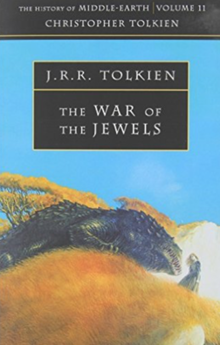|
The War of the Jewels
The War of the Jewels (1994) is the 11th volume of Christopher Tolkien's series The History of Middle-earth, analysing the unpublished manuscripts of his father J. R. R. Tolkien. It is the second of two volumes—Morgoth's Ring being the first—to explore the later 1951 Silmarillion drafts (those written after the completion of The Lord of the Rings).[1] BookContents The volume includes:
InscriptionThere is an inscription in tengwar on the title page of each volume of The History of Middle-earth, written by Christopher Tolkien and describing the contents of the book. The inscription in Volume XI reads "In this book are recorded the last writings of John Ronald Reuel Tolkien concerning the wars of Beleriand, here also is told the story of how Húrin Thali[o]n brought ruin to the Men of Brethil, with much else concerning the Edain and Dwarves and the names of many peoples in the speech of the Elves." ReceptionCharles Noad, reviewing the book in Mallorn, comments that in the early 1950s, Tolkien began many works, but mainly failed to finish them: and that "his creative energies began to desert him just at the time when they were most needed if The Silmarillion, at least on the scale envisioned, were ever to be completed."[2] He adds that "The Wanderings of Húrin" is the first of Tolkien's works to be written in something other than his "characteristic 'high' style": it is in the third person and "non-epic". Noad doubts its value, finding that since it is neither an epic, nor a first-person narrative, it feels unfocused. On the other hand, he found the legend of "The Awakening of the Quendi [Elves]" "fascinating" as it provides the only account of how the race of Elves was envisaged to begin.[2] Noad comments, too, on Christopher Tolkien's numerous expressed doubts over his editing of the published The Silmarillion. Noad observes that it was plainly necessary to publish something, and given that "an edited single-text version with no editorial apparatus" was the goal, then the editorial decisions were inevitably going to be difficult, and second thoughts were "hardly surprising". More broadly, he adds that the History as a whole had done something that a single-volume work could not have achieved: it had changed people's perspective on Tolkien's Middle-earth writings, from being centred on The Lord of the Rings to what it had always been in Tolkien's mind: Silmarillion-centred.[2] References
|
||||||||||||||||||||||||||||||||
Portal di Ensiklopedia Dunia
